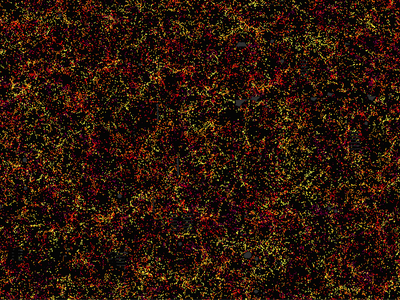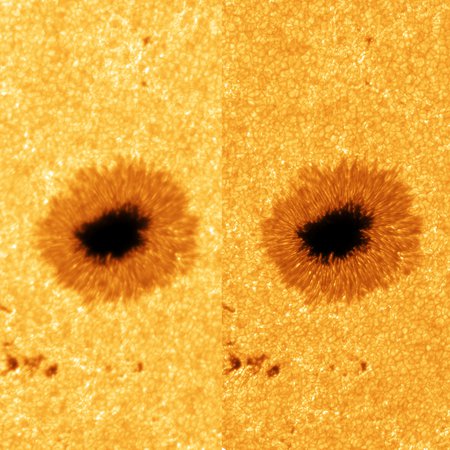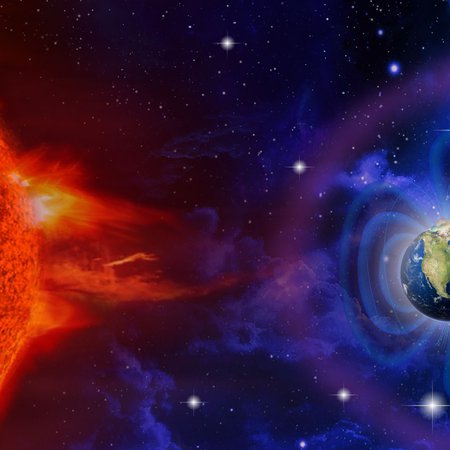The secrets of dark energy
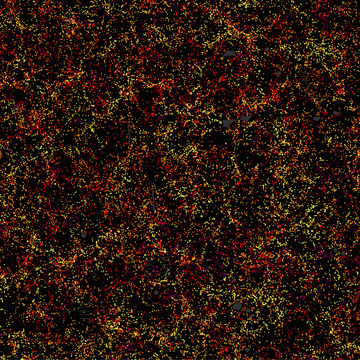
This is one slice through the map of the large-scale structure of the Universe from the Sloan Digital Sky Survey and its Baryon Oscillation Spectroscopic Survey. Each dot in this picture indicates the position of a galaxy 6 billion years into the past. The image covers about 1/20th of the sky, a slice of the Universe 6 billion light-years wide, 4.5 billion light-years high, and 500 million light-years thick. Color indicates distance from Earth, ranging from yellow on the near side of the slice to purple on the far side. Galaxies are highly clustered, revealing superclusters and voids whose presence is seeded in the first fraction of a second after the Big Bang. This image contains 48,741 galaxies, about 3% of the full survey dataset. Grey patches are small regions without survey data.
Credit: Daniel Eisenstein/SDSS-IIIAstronomers announced this week the sharpest results yet on the properties of dark energy driving the accelerated expansion of the Universe. For their studies, scientists from the Baryon Oscillation Spectroscopic Survey (BOSS) programme mapped a record-breaking 1.2 million galaxies observed within the Sloan Digital Sky Survey III (SDSS-III). A collection of papers from the BOSS collaboration describing these results was submitted this week to the Monthly Notices of the Royal Astronomical Society. The Leibniz Institute for Astrophysics Potsdam (AIP) has actively participated with important contributions to data analysis and theoretical modelling.
BOSS measures the expansion rate of the Universe by determining the size of the baryonic acoustic oscillations (BAO) in the three-dimensional distribution of galaxies. The original BAO size is determined by pressure waves that travelled through the young Universe up to when it was only 400,000 years old (the Universe is presently 13.8 billion years old), at which point they became frozen in the matter distribution of the Universe. The end result is that galaxies are preferentially separated by a characteristic distance, that astronomers call the acoustic scale.
The size of the acoustic scale at 13.8 billion years ago has been exquisitely determined from observations of the cosmic microwave background from the light emitted when the pressure waves became frozen. Measuring the distribution of galaxies since that time allows astronomers to measure the acoustic scale at different times and to derive how dark matter and dark energy have competed to govern the rate of expansion of the Universe. Based on BOSS data, the acoustic scale has now been determined with an accuracy of less than one per cent from a point in time 7 billion years ago out to near the present day, two billion years ago.
Chia-Hsun Chuang, postdoctoral researcher at AIP, has contributed to this success by developing a new method to extract cosmological information from BOSS data. His approach jointly considers the cosmic microwave background and the observed three-dimensional galaxy distribution to derive cosmological parameters with minimum assumptions on dark energy. The method was applied to test different dark energy models and confirmed our current understanding of the expansion of the Universe to unprecedented accuracy.
In addition to studying the distribution of the galaxies themselves, AIP scientists Francisco-Shu Kitaura and Chia-Hsun Chuang for the first time also have had a closer look at the density minima in the BOSS data. These are the most quiet places in our Universe characterizing regions devoid of galaxies. By applying a similar analysis on these voids from the BOSS observations, the astronomers could determine the acoustic scale as the characteristic separation between the density minima.
The new BOSS galaxy map also reveals the distinctive signature of the coherent movement of galaxies toward regions of the Universe with more matter, due to the attractive force of gravity. Crucially, the observed amount of infall is explained well by the predictions of general relativity. This agreement supports the idea that the acceleration of the expansion rate is driven by a phenomenon at the largest cosmic scales, such as dark energy, rather than a breakdown of our gravitational theory.
Science Contacts:
Dr. Chia-Hsun Chuang, +49 331 7499 639, achuang@aip.de
Dr. Francisco-Shu Kitaura, +49-331-7499 447, fkitaura@aip.de
Media Contact:
Dr. Gabriele Schönherr, +49 331-7499 804, presse@aip.de
Further information
SDSS original press release: http://www.sdss.org/press-releases/
BOSS programme of the Sloan Digital Sky Survey: https://www.sdss3.org/surveys/boss.php
AIP press release about the simulation of large galaxy catalogues for BOSS: http://www.aip.de/en/news/science/boss
About SDSS:
Funding for SDSS-III has been provided by the Alfred P. Sloan Foundation, the Participating Institutions, the National Science Foundation, and the U.S. Department of Energy Office of Science. The SDSS-III web site is http://www.sdss3.org/.
SDSS-III is managed by the Astrophysical Research Consortium for the Participating Institutions of the SDSS‑III Collaboration including the University of Arizona, the Brazilian Participation Group, Brookhaven National Laboratory, Carnegie Mellon University, University of Florida, the French Participation Group, the German Participation Group, Harvard University, the Instituto de Astrofisica de Canarias, the Michigan State/Notre Dame/JINA Participation Group, Johns Hopkins University, Lawrence Berkeley National Laboratory, Max Planck Institute for Astrophysics, Max Planck Institute for Extraterrestrial Physics, New Mexico State University, New York University, Ohio State University, Pennsylvania State University, University of Portsmouth, Princeton University, the Spanish Participation Group, University of Tokyo, University of Utah, Vanderbilt University, University of Virginia, University of Washington, and Yale University.
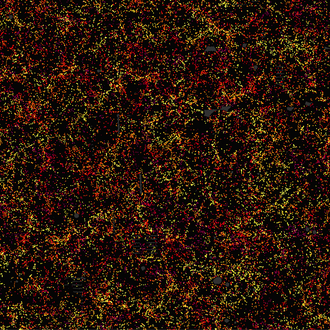
This is one slice through the map of the large-scale structure of the Universe from the Sloan Digital Sky Survey and its Baryon Oscillation Spectroscopic Survey. Each dot in this picture indicates the position of a galaxy 6 billion years into the past. The image covers about 1/20th of the sky, a slice of the Universe 6 billion light-years wide, 4.5 billion light-years high, and 500 million light-years thick. Color indicates distance from Earth, ranging from yellow on the near side of the slice to purple on the far side. Galaxies are highly clustered, revealing superclusters and voids whose presence is seeded in the first fraction of a second after the Big Bang. This image contains 48,741 galaxies, about 3% of the full survey dataset. Grey patches are small regions without survey data.
Credit: Daniel Eisenstein/SDSS-IIIAstronomers announced this week the sharpest results yet on the properties of dark energy driving the accelerated expansion of the Universe. For their studies, scientists from the Baryon Oscillation Spectroscopic Survey (BOSS) programme mapped a record-breaking 1.2 million galaxies observed within the Sloan Digital Sky Survey III (SDSS-III). A collection of papers from the BOSS collaboration describing these results was submitted this week to the Monthly Notices of the Royal Astronomical Society. The Leibniz Institute for Astrophysics Potsdam (AIP) has actively participated with important contributions to data analysis and theoretical modelling.
BOSS measures the expansion rate of the Universe by determining the size of the baryonic acoustic oscillations (BAO) in the three-dimensional distribution of galaxies. The original BAO size is determined by pressure waves that travelled through the young Universe up to when it was only 400,000 years old (the Universe is presently 13.8 billion years old), at which point they became frozen in the matter distribution of the Universe. The end result is that galaxies are preferentially separated by a characteristic distance, that astronomers call the acoustic scale.
The size of the acoustic scale at 13.8 billion years ago has been exquisitely determined from observations of the cosmic microwave background from the light emitted when the pressure waves became frozen. Measuring the distribution of galaxies since that time allows astronomers to measure the acoustic scale at different times and to derive how dark matter and dark energy have competed to govern the rate of expansion of the Universe. Based on BOSS data, the acoustic scale has now been determined with an accuracy of less than one per cent from a point in time 7 billion years ago out to near the present day, two billion years ago.
Chia-Hsun Chuang, postdoctoral researcher at AIP, has contributed to this success by developing a new method to extract cosmological information from BOSS data. His approach jointly considers the cosmic microwave background and the observed three-dimensional galaxy distribution to derive cosmological parameters with minimum assumptions on dark energy. The method was applied to test different dark energy models and confirmed our current understanding of the expansion of the Universe to unprecedented accuracy.
In addition to studying the distribution of the galaxies themselves, AIP scientists Francisco-Shu Kitaura and Chia-Hsun Chuang for the first time also have had a closer look at the density minima in the BOSS data. These are the most quiet places in our Universe characterizing regions devoid of galaxies. By applying a similar analysis on these voids from the BOSS observations, the astronomers could determine the acoustic scale as the characteristic separation between the density minima.
The new BOSS galaxy map also reveals the distinctive signature of the coherent movement of galaxies toward regions of the Universe with more matter, due to the attractive force of gravity. Crucially, the observed amount of infall is explained well by the predictions of general relativity. This agreement supports the idea that the acceleration of the expansion rate is driven by a phenomenon at the largest cosmic scales, such as dark energy, rather than a breakdown of our gravitational theory.
Science Contacts:
Dr. Chia-Hsun Chuang, +49 331 7499 639, achuang@aip.de
Dr. Francisco-Shu Kitaura, +49-331-7499 447, fkitaura@aip.de
Media Contact:
Dr. Gabriele Schönherr, +49 331-7499 804, presse@aip.de
Further information
SDSS original press release: http://www.sdss.org/press-releases/
BOSS programme of the Sloan Digital Sky Survey: https://www.sdss3.org/surveys/boss.php
AIP press release about the simulation of large galaxy catalogues for BOSS: http://www.aip.de/en/news/science/boss
About SDSS:
Funding for SDSS-III has been provided by the Alfred P. Sloan Foundation, the Participating Institutions, the National Science Foundation, and the U.S. Department of Energy Office of Science. The SDSS-III web site is http://www.sdss3.org/.
SDSS-III is managed by the Astrophysical Research Consortium for the Participating Institutions of the SDSS‑III Collaboration including the University of Arizona, the Brazilian Participation Group, Brookhaven National Laboratory, Carnegie Mellon University, University of Florida, the French Participation Group, the German Participation Group, Harvard University, the Instituto de Astrofisica de Canarias, the Michigan State/Notre Dame/JINA Participation Group, Johns Hopkins University, Lawrence Berkeley National Laboratory, Max Planck Institute for Astrophysics, Max Planck Institute for Extraterrestrial Physics, New Mexico State University, New York University, Ohio State University, Pennsylvania State University, University of Portsmouth, Princeton University, the Spanish Participation Group, University of Tokyo, University of Utah, Vanderbilt University, University of Virginia, University of Washington, and Yale University.
Images
This is one slice through the map of the large-scale structure of the Universe from the Sloan Digital Sky Survey and its Baryon Oscillation Spectroscopic Survey. Each dot in this picture indicates the position of a galaxy 6 billion years into the past. The image covers about 1/20th of the sky, a slice of the Universe 6 billion light-years wide, 4.5 billion light-years high, and 500 million light-years thick. Color indicates distance from Earth, ranging from yellow on the near side of the slice to purple on the far side. Galaxies are highly clustered, revealing superclusters and voids whose presence is seeded in the first fraction of a second after the Big Bang. This image contains 48,741 galaxies, about 3% of the full survey dataset. Grey patches are small regions without survey data.
Big screen size [1000 x 748, 1.5 MB]
Original size [1300 x 973, 2.1 MB]
